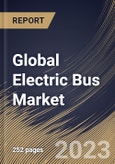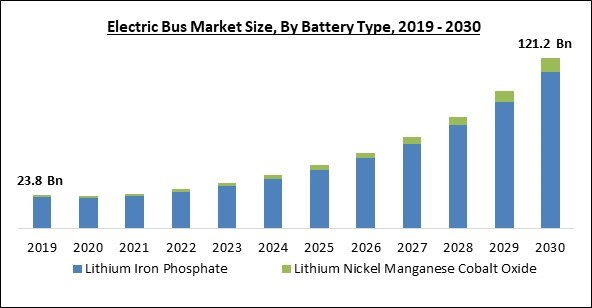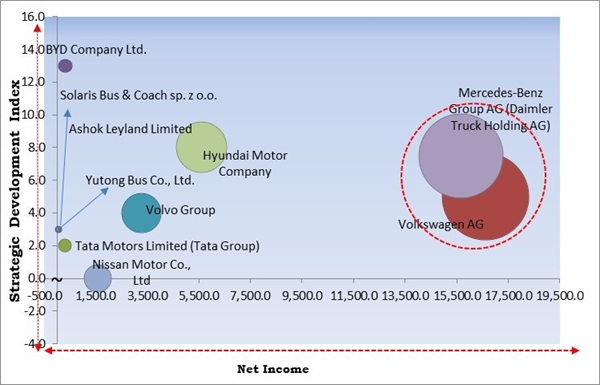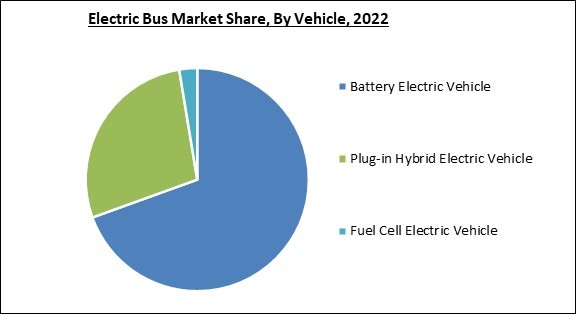The Global Electric Bus Market size is expected to reach $121.2 billion by 2030, rising at a market growth of 20.8% CAGR during the forecast period.
Battery Electric Vehicle are gaining traction in the Market due to the rising greenhouse gas (GHG) emissions. Therefore, Battery Electric Vehicle accounted for $19.3 billion revenue in the market in 2022. Employing hydrogen energy for transportation as well as business and industrial uses will drastically cut GHG emissions. The announcement of GHG emission reduction targets has compelled bus makers to use electric alternatives. For example, 2019 saw the establishment of the Colorado emissions reduction target in the US. By setting the baseline at its 2005 levels, it has set reduction goals of 26% by 2025, 50% by 2030, and 90% by 2050. Similarly, by 2030, Germany wants to reduce carbon emissions by at least 65% compared to 1990 levels. One of the leading nations in adopting electric buses is the Netherlands, which already employs electric public buses in day-to-day operations and wants to have all of its public bus transportation emission-free by 2030. The market is anticipated to increase as a result.
The major strategies followed by the market participants are Product Launches as the key developmental strategy in order to keep pace with the changing demands of end users. For instance, In June, 2023, Yutong Bus Co., Ltd. announced the launch of YEA, a technology platform for energy commercial vehicles. The YEA features two core components namely, the C-architecture used as a CPU of the commercial vehicle and the YOS, a commercial vehicle operating system featuring a self-developed OS by Yutong Bus. Additionally, In April,2023, Daimler Truck AG unveiled the Rizon brand of medium-duty trucks. The Rizon branded trucks feature lithium iron phosphate batteries and a single charge mileage of up to 110 miles.
Based on the Analysis presented in the The Cardinal Matrix; Volkswagen AG and Mercedes-Benz Group AG (Daimler Truck Holding AG) are the forerunners in the Market. In June, 2023, Volkswagen AG released ID. Buzz electric bus. The ID. Buzz features an electric motor capable of producing power of up to 282 horsepower and a maximum speed of up to 99 mph. Furthermore, the bus features power-sliding doors on both sides. Companies such as Hyundai Motor Company, Volvo Group, Nissan Motor Co., Ltd are some of the key innovators in the Market.
The market research report covers the analysis of key stake holders of the market. Key companies profiled in the report include BYD Company Ltd., Volvo Group, Solaris Bus & Coach sp. z o.o. (Construcciones y Auxiliar de Ferrocarriles, S.A.), Volkswagen AG, Nissan Motor Co., Ltd, Ashok Leyland Limited (Hinduja Group Ltd.), Mercedes-Benz Group AG (Daimler Truck Holding AG), Yutong Bus Co., Ltd., Tata Motors Limited (Tata Group) and Hyundai Motor Company.
Battery Electric Vehicle are gaining traction in the Market due to the rising greenhouse gas (GHG) emissions. Therefore, Battery Electric Vehicle accounted for $19.3 billion revenue in the market in 2022. Employing hydrogen energy for transportation as well as business and industrial uses will drastically cut GHG emissions. The announcement of GHG emission reduction targets has compelled bus makers to use electric alternatives. For example, 2019 saw the establishment of the Colorado emissions reduction target in the US. By setting the baseline at its 2005 levels, it has set reduction goals of 26% by 2025, 50% by 2030, and 90% by 2050. Similarly, by 2030, Germany wants to reduce carbon emissions by at least 65% compared to 1990 levels. One of the leading nations in adopting electric buses is the Netherlands, which already employs electric public buses in day-to-day operations and wants to have all of its public bus transportation emission-free by 2030. The market is anticipated to increase as a result.
The major strategies followed by the market participants are Product Launches as the key developmental strategy in order to keep pace with the changing demands of end users. For instance, In June, 2023, Yutong Bus Co., Ltd. announced the launch of YEA, a technology platform for energy commercial vehicles. The YEA features two core components namely, the C-architecture used as a CPU of the commercial vehicle and the YOS, a commercial vehicle operating system featuring a self-developed OS by Yutong Bus. Additionally, In April,2023, Daimler Truck AG unveiled the Rizon brand of medium-duty trucks. The Rizon branded trucks feature lithium iron phosphate batteries and a single charge mileage of up to 110 miles.
The Cardinal Matrix - Market Competition Analysis
Based on the Analysis presented in the The Cardinal Matrix; Volkswagen AG and Mercedes-Benz Group AG (Daimler Truck Holding AG) are the forerunners in the Market. In June, 2023, Volkswagen AG released ID. Buzz electric bus. The ID. Buzz features an electric motor capable of producing power of up to 282 horsepower and a maximum speed of up to 99 mph. Furthermore, the bus features power-sliding doors on both sides. Companies such as Hyundai Motor Company, Volvo Group, Nissan Motor Co., Ltd are some of the key innovators in the Market.
Market Growth Factors
Escalating prices for diesel and petrol
Compared to a comparable gasoline or diesel vehicle, an electric car offers substantially reduced operating costs. Instead of using fossil fuels like gasoline or diesel, electric vehicles charge their batteries using energy. Due to their superior efficiency and lower cost of energy, electric automobiles are more affordable to charge than gasoline or diesel vehicles. Deploying electric vehicles can help protect the environment when powered by renewable energy. If charging is done using renewable energy sources like solar panels placed in bus depots, the cost of electricity can be further decreased. Due to this, nations are moving from conventional to electric vehicles worldwide, causing the market to grow.Use of advanced technologies, rapid industrialization, and electrification
Rapid urbanization, fast population growth, the expansion of the industrial sector, and infrastructural development are the primary drivers of the significant increase in good transport vehicles worldwide. Numerous job opportunities are emerging in several industries, like mining, building, and tourism, due to the expansion of the industrial sector, especially in developing countries. As a result, since there are more employment opportunities, there are also more commuters, which has an important impact on the demand for public transportation services. This factor is driving the demand for efficient public transport modes.Market Restraining Factors
High development costs and safety issues with EV batteries
The battery needs a management system that guarantees the best operational temperature and security. However, manufacturers must spend a lot of time and money on advanced battery management systems inventions. Regarding electric buses, the size of the battery pack affects both the vehicle's driving range and the battery price. Further complicating the design of the body and chassis of electric buses is the large battery size. Depending on several factors, including the annual/daily mileage, operating temperature, and charging level/rate, these batteries must be replaced at least once or twice throughout the bus's operational lifespan. As a result, such factors are proving to be a significant barrier to market expansion.Battery Type Outlook
On the basis of battery type, the market is classified into lithium nickel manganese cobalt oxide and lithium iron phosphate. The lithium nickel manganese cobalt oxide segment recorded a significant revenue share in the market in 2022. The minerals in this type of rechargeable lithium-ion batteries are used in powder form in batch numbers as a cathode material. Extremely great thermal stability characterizes this material. The nickel magnesium cobalt battery has become more popular for use in electric buses because of its beneficial characteristics, which include a high capacity, cycle rate, and power, in addition to a low self-heating rate.Vehicle Outlook
Based on Vehicle, the market is characterized into battery electric vehicle, plug-in hybrid electric vehicle, and fuel cell electric vehicle. The fuel cell electric vehicle (FCEV) segment procured a considerable growth rate in the market in 2022. Greenhouse gas emissions and air pollution are reduced in part owing to the FCEV. The segment is expanding due to more aggressive government attempts to cut carbon emissions and save the environment. For instance, the use of fuel-cell transit buses is accelerating in Germany. For the production and installation of electric public transportation vehicles in the nation, the German government has made significant contributions.Application Outlook
By application, the market is divided into intercity and intracity. The intracity segment garnered a remarkable growth rate in the market in 2022. The segment is expanding as developing economies become more aware of the need to decrease carbon emissions and as severe emission regulations encourage the usage of electric buses. Clean mobility solutions are now essential due to rising urbanization. Urban population growth would necessitate widespread urban transit, which offers tremendous possibilities for electric mobility.End-user Outlook
Based on end-use, the market is segmented into public and private. The public segment procured the highest revenue share in the market in 2022. A significant proportion of the market is linked to the rising demand for transportation services as well as government initiatives to minimize greenhouse gas emissions and reliance on fossil fuels. Public initiatives often focus on developing the necessary charging infrastructure to support electric buses. This includes the installation of charging stations at bus depots, terminals, and along bus routes.Regional Outlook
Region wise, the market is analyzed across North America, Europe, Asia Pacific, and LAMEA. The Asia Pacific segment recorded the largest revenue share in the market in 2022. The rise in demand for environmentally friendly transportation and the presence of nations like India, China, and Japan are responsible for the expansion. China is a significant player in the market and the location of top manufacturers. For instance, there were over 466,000 New Energy buses (NEBs) in China by the end of 2020, of which 378,700 were battery electric buses. Strict government regulations, environmental concerns, and expanding charging infrastructure are also boosting the region's demand.The market research report covers the analysis of key stake holders of the market. Key companies profiled in the report include BYD Company Ltd., Volvo Group, Solaris Bus & Coach sp. z o.o. (Construcciones y Auxiliar de Ferrocarriles, S.A.), Volkswagen AG, Nissan Motor Co., Ltd, Ashok Leyland Limited (Hinduja Group Ltd.), Mercedes-Benz Group AG (Daimler Truck Holding AG), Yutong Bus Co., Ltd., Tata Motors Limited (Tata Group) and Hyundai Motor Company.
Strategies Deployed in the Market
Partnerships, Collaborations and Agreements:
- Apr-2023: Volvo Group came into partnership with Manufacturing Commercial Vehicles (MCV), an Egyptian bus manufacturer, to manufacture bodies for Volvo's electric buses. The partnership provides better flexibility for Volvo to meet the market demand.
- Mar-2023: Daimler Truck AG signed a partnership with Siemens, a German automation solutions provider, to build a digital engineering platform with the use of Siemens Xcelerator portfolio of software and services. The partnership would allow Daimler to develop state-of-art technologies that would be used by Daimler's customers to boost their productivity.
- Dec-2022: Tata Motors Limited came into an agreement with Delhi Transport Corporation, a public transport operator based in Delhi, India, to supply 1500 electric buses in Delhi. The partnership would allow Tata Motors to provide its customers based in Delhi with zero-emission buses.
- Oct-2022: Daimler Truck AG signed an agreement with Gehring Technologies GmbH + Co. KG, a machinery manufacturer based in Germany, to build solutions for vehicle electric vehicles. The partnership aids the company in its ambition to build “truck-e-fied” e-motors.
- May-2022: Hyundai Motor Company signed a partnership with Tata Power, a power distributor based in India, to build infrastructure for Electric Vehicles. The partnership allows Hyundai to strengthen its position in the Indian market by providing customers with a robust EV ecosystem.
- Mar-2022: Volkswagen AG announced an extended partnership with Ford Motor Company, an automobile manufacturer based in the United States, to provide solutions for e-mobility. The partnership sped up Volkswagen's electrification capabilities, thereby allowing it to serve the customers in a better way.
- Dec-2021: BYD UK, a subsidiary of BYD Company Ltd., signed a partnership with Alexander Dennis Limited, a bus manufacturer based in Britain, to supply its electric vehicles to the Scottish market. The partnership allows BYD to provide its Scottish customers with innovative solutions for zero-emission transport solutions.
- Jul-2021: BYD UK, a subsidiary of BYD Company Ltd., partnered with Alexander Dennis Limited, a bus manufacturer based in Britain, to supply 200 BYD ADL Enviro200EV to the Irish market. The partnership brings zero-emission transport solutions to the Irish customers of BYD, thereby allowing them to serve their customers in a better way.
Product Launch and Product Expansion:
- Jun-2023: Volkswagen AG released ID. Buzz electric bus. The ID. Buzz features an electric motor capable of producing power of up to 282 horsepower and a maximum speed of up to 99 mph. Furthermore, the bus features power-sliding doors on both sides.
- Jun-2023: Yutong Bus Co., Ltd. announced the launch of YEA, a technology platform for energy commercial vehicles. The YEA features two core components namely, the C-architecture used as a CPU of the commercial vehicle and the YOS, a commercial vehicle operating system featuring a self-developed OS by Yutong Bus.
- Apr-2023: Daimler Truck AG unveiled the Rizon brand of medium-duty trucks. The Rizon branded trucks feature lithium iron phosphate batteries and a single charge mileage of up to 110 miles.
- Jun-2022: Switch Mobility Ltd, a subsidiary of Ashok Leyland Limited, introduced Switch EiV 12 electric buses. The Switch EiV 12 electric buses feature ‘Switch iON’ remote monitoring services and NMC lithium-ion powered modular batteries.
- Feb-2022: BYD Company Ltd. unveiled K6 electric bus. The K6 electric bus is a 20-seater bus that has a single-charge mileage of up to 140 miles.
- Sep-2021: Solaris Bus & Coach sp. z o.o. announced the launch of Urbino 9 LE electric bus. The Urbino 9 LE electric bus has a power output of up to 220kW and features high-energy batteries with capacities of up to 350 kWh.
Geographical Expansions:
- Mar-2022: Daimler Truck AG expanded its geographical reach by opening The Daimler Truck Innovation Center India (DTICI) in Bangalore, India. The new center would serve as research and development for Daimler and would aid the company in strengthening its market share.
Scope of the Study
By Battery Type
- Lithium Iron Phosphate
- Lithium Nickel Manganese Cobalt Oxide
By Vehicle
- Battery Electric Vehicle
- Plug-in Hybrid Electric Vehicle
- Fuel Cell Electric Vehicle
By Application
- Intercity
- Intracity
By End-Use
- Public
- Private
By Geography
- North America
- US
- Canada
- Mexico
- Rest of North America
- Europe
- Germany
- UK
- France
- Russia
- Spain
- Italy
- Rest of Europe
- Asia Pacific
- China
- Japan
- India
- South Korea
- Singapore
- Malaysia
- Rest of Asia Pacific
- LAMEA
- Brazil
- Argentina
- UAE
- Saudi Arabia
- South Africa
- Nigeria
- Rest of LAMEA
Key Market Players
List of Companies Profiled in the Report:
- BYD Company Ltd.
- Volvo Group
- Solaris Bus & Coach sp. z o.o. (Construcciones y Auxiliar de Ferrocarriles, S.A.)
- Volkswagen AG
- Nissan Motor Co., Ltd
- Ashok Leyland Limited (Hinduja Group Ltd.)
- Mercedes-Benz Group AG (Daimler Truck Holding AG)
- Yutong Bus Co., Ltd.
- Tata Motors Limited (Tata Group)
- Hyundai Motor Company
Unique Offerings
- Exhaustive coverage
- The highest number of Market tables and figures
- Subscription-based model available
- Guaranteed best price
- Assured post sales research support with 10% customization free
Table of Contents
Chapter 1. Market Scope & Methodology
Chapter 2. Market Overview
Chapter 3. Competition Analysis - Global
Chapter 4. Global Electric Bus Market by Battery Type
Chapter 5. Global Electric Bus Market by Vehicle
Chapter 6. Global Electric Bus Market by Application
Chapter 7. Global Electric Bus Market by End-use
Chapter 8. Global Electric Bus Market by Region
Chapter 9. Company Profiles
Companies Mentioned
- BYD Company Ltd.
- Volvo Group
- Solaris Bus & Coach sp. z o.o. (Construcciones y Auxiliar de Ferrocarriles, S.A.)
- Volkswagen AG
- Nissan Motor Co., Ltd
- Ashok Leyland Limited (Hinduja Group Ltd.)
- Mercedes-Benz Group AG (Daimler Truck Holding AG)
- Yutong Bus Co., Ltd.
- Tata Motors Limited (Tata Group)
- Hyundai Motor Company
Methodology

LOADING...











